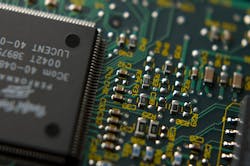Semiconductor market lurching toward worst-in-a-decade downturn: IHS Markit
Conditions in the global semiconductor market have deteriorated rapidly since the start of the year, with business information provider IHS Markit slashing its 2019 growth outlook by more than 10 percentage points.
According to the analyst, the worldwide microchip industry is set to suffer a 7.4 percent drop in revenue this year, according to the latest figures from the IHS Markit Application Market Forecast Tool (AMFT). Revenue will reportedly fall to $446.2 billion in 2019, down from $482.0 billion in 2018. This represents a major swing in the market outlook compared to the previous forecast in December, which anticipated the market would expand by 2.9 percent this year.
A 7.4 percent decline will mark the semiconductor industry’s biggest annual percentage decrease since the Great Recession year of 2009, when chip sales plunged by nearly 11 percent, as illustrated in the figure.
“After the chip industry attained a heady revenue expansion of 15 percent in 2018, many semiconductor suppliers in early 2019 remained optimistic that they could achieve modest growth this year,” said Myson Robles Bruce, research manager, semiconductor value chain, at IHS Markit. “However, the chipmakers’ confidence quickly transformed into apprehension as they witnessed the depth and ferocity of the current downturn. The latest data indicates the semiconductor business now is destined for its worst year in a decade.”
The chips are down
IHS Markit says the precipitous nature of the downturn is due to increasingly soft demand, combined with a rapid rise in inventory levels in the first quarter. These events have impacted some semiconductor product segments more than others. DRAM, NAND flash, general-purpose microprocessors (MPUs), 32-bit microcontrollers (MCUs) and analog application-specific integrated circuits (ASICs) were among the worst-affected products, with all of them double-digit revenue declines in the first quarter of 2019 compared to the first quarter of 2018.
RELATED: Marvell to acquire multi-gig Ethernet connectivity specialist Aquantia
Recent concerns over DRAM market conditions, a harsh drop in average selling prices, and weak demand all served to slash DRAM revenue projections for 2019. In the NAND flash memory space continued oversupply has been responsible for an aggressive erosion in pricing. Another segment set for steep decline this year, according to the analyst, is the logic application-specific standard product (ASSP) where demand is driven by the mobile handset business, a market that is struggling to generate due to nearly universal saturation.
A silicon silver lining
The challenging conditions in the semiconductor market will linger through the second quarter. The sharp declines in the first half of the year may have set the chip market on a course for its worst revenue performance since 2009 -- however, IHS Markit Technology forecasts a recovery in semiconductor sales in the third quarter. The firm expects this revival will be led by NAND flash memory parts used in solid-state drives and high-end smartphones.
MPUs employed in notebook PCs and data center servers also will help drive a resumption of overall semiconductor sales growth, added IHS Markit.

